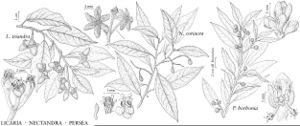Persea
Gard. Dict. Abr. ed. 4. 1754, name conserved.
| Taxon | Illustrator ⠉ | |
|---|---|---|
 | Nectandra coriacea Persea borbonia Licaria triandra | John Myers John Myers John Myers |
Shrubs to medium-sized trees, evergreen. Bark reddish-brown, thin, fissured. Leaves alternate, aromatic. Leaf-blade pinnately veined; surfaces pubescent, especially abaxially, becoming glabrescent with age; domatia absent. Inflorescence appearing when mature leaves present, axillary, flowers in pedunculate, compound cymes. Flowers bisexual; tepals persistent, yellowish, pubescent, outer tepals slightly shorter than inner; stamens 9, anthers 4-locular, 4-valved, anthers of outer 6 stamens introrse, anthers of inner 3 latrorse; staminodes 3, sagittate; ovary nearly globose. Drupe dark blue to black, nearly globose, borne on pedicel with tepals persistent at base; cupule absent. x = 12.
Distribution
Tropical and subtropical regions, Western Hemisphere
Discussion
Species ca. 150 (3 in the flora).
Persea americana Miller, the avocado of commerce, with large, fleshy fruits and deciduous tepals, is widely grown in California and Florida. It may persist after cultivation.
Pubescence type and density are the most reliable characteristics in identifying species and are best seen on young leaves and branches.
Selected References
None.
Lower Taxa
Key
| 1 | Pubescence of branches and leaves erect, crisped; peduncle longer than subtending leaf petiole. | Persea palustris |
| 1 | Pubescence of branches and leaves appressed; peduncle equal to or shorter than subtending leaf petiole. | > 2 |
| 2 | Abaxial leaf surface moderately pubescent, glabrescent with age; leaf blade 6–16 cm. | Persea borbonia |
| 2 | Abaxial leaf surface densely pubescent, appearing sooty with age; leaf blade 5–8 cm. | Persea humilis |